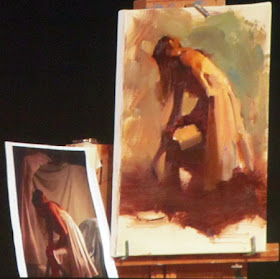"I start with three values. At the beginning I keep the treatment of shadows flat, with almost no form, but I keep lots of color. After working on the shadows I begin working on the light side."
"I start with a 2D approach, thinking first of shape, then of value, and then color. First comes 2D—shapes and angles; then 3D—form, volume, and structure."

"I use thicker paint on the light side to give texture. Some touches of the brush are very delicate, and some are more scumbling. At the final stages, edge control is very important. There should be a lost and found quality to the edges in order to show atmosphere and depth."
Zhaoming Wu gave a lot of consideration to the transition areas between light and shadow. He brushed along, but also across, the forms, alternately softening and defining edges all the way from start to finish.
He stood evenly on both feet, holding the brush well back from the ferrule, and considering each stroke carefully, flicking the brush upward after each stroke was completed. The small accents of the dress and the hair came at the very last.
New book: Selected Oil Paintings by Wu Zhaoming: Oversea Chinese Oil Painters (Chinese Edition)
Zhaoming Wu website
Plein Air convention
YouTube video of Zhaoming Wu




Thanks for sharing, James! I took Zhaoming's class a few times when I was a student at AAU- watching him work is mesmerizing. It's telling that all his notes and lectures focus on such broad, basic ideas. I don't think I ever once heard him focus in on details and particulars, even during critiques. Always the basics.
ReplyDeleteZhaoming Wu is an artist I've admired from afar for a long time... I often look at his works on his website for inspiration, but I know almost nothing about him or how he works. This glimpse into his approach is great, I really appreciate you taking the time to write this up, James! Sounds like you're having a fun time there...
ReplyDeleteThanks so much for sharing these demos. How great it must be to see these artist's work in person, but for those of us who can't this is a special treat. Thanks again!
ReplyDeleteI appreciated Zhaoming Wu's mention of lost and found lines. That's a technique that (though I sometimes forget to employ it) I find particularly effective. I can't recall if you've done a posting on that...and come to think of it, I'm not sure how much there is to say other than the obvious. But maybe a subject for a future post?
I think I like this demo better than the more finished paintings on his web site. Thanks for sharing.
ReplyDeletewas this done from a live model? in one of the photos it looks like he's working from a photograph! That detail is an important distinction in the process and I saw no mention of it in the notes. Thanks for clarifying!
ReplyDeleteEmilie, it was done from a photo, which you can see in one of the images.
ReplyDeleteOf all my former instruction, I learned the most from Zhaoming Wu.
ReplyDeleteThis comment has been removed by the author.
ReplyDeleteI took a weeklong workshop with Zhaoming a few years ago. He's a fine teacher, and all his demos were from live models. I doubt he used a photo for this one. Each summer he teaches a workshop at the Whidby Fine Arts Studio on Whidbey Island, north of Seattle.
ReplyDeleteWoops, I stand corrected about the photo.
ReplyDelete